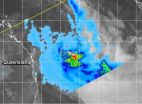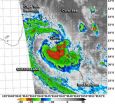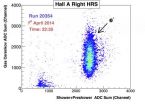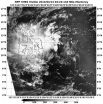(Press-News.org) Tropical Cyclone Ita made landfall in northeastern Queensland, Australia on April 11 as a powerful Category 4 hurricane on the Saffir-Simpson scale, moved south and re-emerged in the Coral Sea on April 14 where NASA's TRMM and NASA-NOAA's Suomi NPP Satellites captured imagery of the weakened storm.
The VIIRS instrument aboard NASA-NOAA's Suomi NPP satellite captured a visible look at Ita's elongating structure on April 14 at 4:12 UTC/12:12. The Visible Infrared Imaging Radiometer Suite (VIIRS) instrument collects visible and infrared imagery and global observations of land, atmosphere, cryosphere and oceans. Strong northwesterly vertical wind shear was evident because the bulk of the storm's clouds were pushed southeast of the center. The VIIRS image also revealed that Ita no longer maintained a rounded shape.
NASA and the Japan Aerospace Exploration Agency's Tropical Rainfall Measuring Mission (TRMM) satellite's Precipitation Radar instrument gathered rainfall data from Ita when it flew overhead on April 14. That rainfall data was combined with infrared data of Ita's clouds from Japan's MTSAT-2 satellite.
The image taken on April 14 at 1050 UTC/6:50 a.m. EDT showed rain fall rates of up to 1.4 inches/35.5 mm per hour falling southeast of Ita's elongated center.
After Tropical cyclone Ita made landfall on April 11, it continued tracking over land on the eastern Cape York Peninsula of Queensland, Australia where it weakened to a tropical storm. The Moderate Resolution Imaging Spectroradiometer (MODIS) instrument aboard NASA's Terra satellite captured an infrared image of Ita on April 12 at 1225 UTC/8:25 a.m. EDT. The MODIS image showed very high, powerful thunderstorms with very cold cloud top temperatures were south of the center of circulation. The thick band of thunderstorms had cloud top temperatures that were as cold as -80F/-62.2C. Those thunderstorms had the potential for heavy rainfall.
According to the Brisbane Times, Ita did not cause any loss of life, but did damage agriculture. Ita reportedly destroyed banana crops and flattened cane fields. Flooding from heavy rainfall also cut off the Bruce Highway, Queensland's main highway.
On April 12 at 1200 UTC (8 a.m. EDT U.S. and April 13 at 2:00 a.m. local time) the Australian Bureau of Meteorology (ABM) noted that a Cyclone Warning remained in effect for coastal areas from Cape Tribulation to St. Lawrence. A Cyclone Watch remained in effect for coastal areas from St. Lawrence to Yeppoon. Heavy rainfall, flash flooding, gale-force winds and rough surf can be expected in the warning area. ABM warned that abnormally high tides were expected between Innisfail and Townsville.
On April 12, the Joint Typhoon Warning Center (JTWC) reported animated multispectral satellite imagery revealed that Ita's structure remained well-defined, even over land. Radar imagery from Cairns showed strong bands of thunderstorms along the eastern quadrant of the storm.
On April 12 at 0900 UTC/5 a.m. EDT, Tropical Storm Ita had maximum sustained winds near 50 knots/57.5 mph/92.6 kph. It was centered near 17.0 south latitude and 145.5 east longitude, about 31 nautical miles/35.7 miles/57.4 km west-northwest of Cairns, Queensland. Tropical cyclone Ita has tracked south-southeastward at 6 knots/6.9 miles/11.1 kph.
By April 13 at 12:06 UTC/7 a.m. local time Monday/8 p.m. EDT/U.S., Ita's maximum sustained winds dropped to 45 knots/51.7 mph/83.3 kph. Tropical Cyclone Ita was located off the central Queensland coast near latitude 22.0 south longitude 152.2 east, which is about 121.2 miles/195 km northeast of Yeppoon and 142.9 miles/230 km north northeast of Gladstone.
Satellite imagery showed that the bulk of the convection and thunderstorms associated with Ita were being blown to the south of the center because of strong northwesterly wind shear.
The JTWC's final warning on Ita was issued on April 14 at 0900 UTC/5 a.m. EDT when Ita was back over the Coral Sea. At that time, Ita's maximum sustained winds were down to 40 knots/46.0 mph/74.0 kph. It was centered near 23.7 north latitude and 155.1 east longitude, about 299.2 miles/481.5 km north-northeast of Brisbane, Queensland, Australia. Tropical Storm Ita was moving to the east-southeast at 23 knots/26.4 mph/42.6 kph. All warnings in Queensland were canceled.
JTWC forecasters using animated multispectral satellite imagery noted that Ita was quickly becoming extra-tropical. Ita was embedded in the mid-latitude westerly winds and as a result of that its circulation was starting to stretch out. Strong vertical wind shear was also pushing the strongest thunderstorms to the southeast of the center, and Ita had began taking on frontal characteristics.
JTWC forecasters expect that the vertical wind shear from the westerly winds will speed up the transition into an extra-tropical storm, and by April 15, Ita is expected to be fully extra-tropical.
INFORMATION:
NASA sees Tropical Cyclone Ita over the Coral Sea
2014-04-14
ELSE PRESS RELEASES FROM THIS DATE:
Website information on colon cancer too complex, fails to address key concerns
2014-04-14
DALLAS – April 14, 2014 – Popular web information on colorectal cancer is too difficult for most lay people to read and doesn't address the appropriate risks to and concerns of patients, a study by UT Southwestern Medical Center gastroenterologists suggests.
In a review of a dozen popular websites, most of the online patient education materials for colorectal cancer screening were written beyond the recommended sixth-grade reading level, while content on the sites failed to address key risks, as well as the barriers to and benefits of screening, according to the study's ...
Beam on target!
2014-04-14
Late on April 1, the crown jewel of the Department of Energy's Thomas Jefferson National Accelerator Facility ("Jefferson Lab") sparkled its way into a new era. Following an upgrade of the Continuous Electron Beam Accelerator Facility, the CEBAF accelerator delivered the highest-energy electron beams it has ever produced into a target in an experimental hall, recording the first data of the 12 GeV era. The machine sent electrons around the racetrack three times (known as "3-pass" beam), resulting in 6.11 GeV electrons at 2 nanoAmps average current for more than an hour.
"This ...
NASA sees remnants of Tropical Depression Peipah over Southern Philippines
2014-04-14
Tropical Depression Peipah has been very stubborn and has moved over the southern and central Philippines bringing clouds, showers and gusty winds. NASA-NOAA's Suomi NPP satellite captured an image that showed Peipah's clouds covering the Visayas and Mindanao regions of the country.
The VIIRS instrument aboard NASA-NOAA's Suomi NPP satellite captured a visible look at the remnant clouds associated with former Tropical Depression Peipah on April 14 at 4:24 UTC/12:24 a.m. EDT. The Visible Infrared Imaging Radiometer Suite (VIIRS) instrument collects visible and infrared ...
Pharmacists can significantly improve blood pressure, cholesterol in stroke patients
2014-04-14
Stroke patients managed by a pharmacist had a 12.5% improvement in blood pressure and low-density lipoprotein (LDL), or "bad" cholesterol levels compared with a control group, according to a clinical trial published in CMAJ (Canadian Medical Association Journal).
Patients who have a stroke or "mini stroke" (transient ischemic attack) are at high risk of adverse cardiovascular events. Management of high blood pressure and cholesterol after a stroke is important because it can substantially reduce the risk of a negative event; however, many patients receive suboptimal care. ...
'MicroRNA' could be key target for bowel cancer treatment
2014-04-14
Scientists found that the molecule, called microRNA 135b, is a vital 'worker' employed by several important cancer genes to drive the growth of bowel cancers.
Drugs targeted at the microRNA could knock out the effects of multiple cancer-causing mutations at once, while tests for it could identify patients with the most aggressive disease, the researchers believe.
The research was carried out by an international team including scientists based at The Institute of Cancer Research, London, the University of Glasgow and Ohio State University in the US.
Scientists tested ...
Study identifies a likely key driver of colorectal cancer development and progression
2014-04-14
COLUMBUS, Ohio – A new study identifies a molecule that is a probable driving force in colorectal cancer and suggests that the molecule could be an important target for colorectal cancer treatment and a valuable biomarker of tumor progression.
The study of microRNA-135b (miR-135b) in two animal models and human tumors was published in the journal Cancer Cell and was led by researchers at The Ohio State University Comprehensive Cancer Center – Arthur G. James Cancer Hospital and Richard J. Solove Research Institute (OSUCCC – James) and at the University of Glasgow in ...
Dietary supplement use among US adults more prevalent than previously thought
2014-04-14
Washington, D.C., April 14, 2014—Dietary supplement use by U.S. adults is more prevalent than indicated by published data from the National Health and Nutrition Examination Surveys (NHANES), according to a new article in the peer-reviewed Journal of the American College of Nutrition (JACN). The review article is based on five consecutive years of online market research studies, conducted by Ipsos Public Affairs for the Council for Responsible Nutrition (CRN).
According to Annette Dickinson, Ph.D., corresponding author and a consultant for CRN, "This new review adds to ...
Young dads at high risk of depression, too
2014-04-14
CHICAGO --- Depression can hit young fathers hard -- with symptoms increasing dramatically during some of the most important years of their children's lives, a new Northwestern Medicine® study has found.
Depressive symptoms increased on average by 68 percent over the first five years of fatherhood for these young men, who were around 25 years old when they became fathers and whom lived in the same home as their children. The results of the study were published April 14 in the journal Pediatrics.
This study is the first to identify when young fathers are at increased ...
Osteoporosis drugs appear to impede cell membrane repair
2014-04-14
AUGUSTA, Ga. –A class of drugs widely used to treat osteoporosis appears to impede a cell's ability to repair a protective outer membrane that helps determine what enters and exits, researchers report.
The inability to quickly repair a membrane is lethal to a cell and may help explain the rare and serious side effect of jawbone destruction that can occur following dental work in patients taking these drugs, said Caroline Lewis, a sophomore at the Medical College of Georgia at Georgia Regents University.
"The bottom line is it inhibits cell membrane repair in two distinct ...
Long-term antibiotic treatment for Q fever causes weight gain
2014-04-14
Scientists have unearthed still more evidence that antibiotics can contribute to obesity. Research published ahead of print in the journal Antimicrobial Agents and Chemotherapy suggests that patients on long-term antibiotic treatment gained weight and had significant changes in their gut microbiota.
The study, led by Didier Raoult, of Aix-Marseille University, Marseille, France, followed 48 patients who were being treated long-term with doxycycline and hydroxychloroquine for Q fever, and 34 control subjects. Nearly one quarter of the treated patients gained anywhere ...






